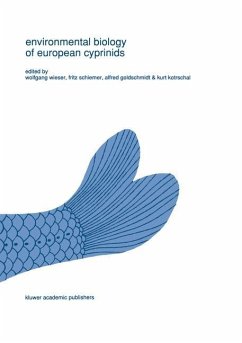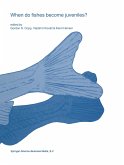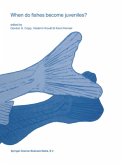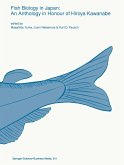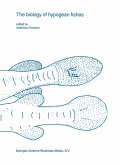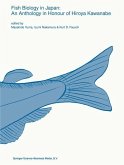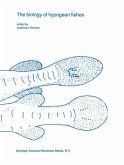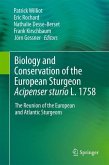W. Wieser / F. Schiemer / A. Goldschmidt / K. Kotrschal (eds.)Papers from the workshop on ¿The Environmental Biology of Cyprinids¿ held at the University of Salzburg, Austria, in September 1989
Environmental biology of European cyprinids
Papers from the workshop on ¿The Environmental Biology of Cyprinids¿ held at the University of Salzburg, Austria, in September 1989
Herausgegeben:Wieser, W.; Schiemer, F.; Goldschmidt, A.; Kotrschal, K.
W. Wieser / F. Schiemer / A. Goldschmidt / K. Kotrschal (eds.)Papers from the workshop on ¿The Environmental Biology of Cyprinids¿ held at the University of Salzburg, Austria, in September 1989
Environmental biology of European cyprinids
Papers from the workshop on ¿The Environmental Biology of Cyprinids¿ held at the University of Salzburg, Austria, in September 1989
Herausgegeben:Wieser, W.; Schiemer, F.; Goldschmidt, A.; Kotrschal, K.
- Gebundenes Buch
- Merkliste
- Auf die Merkliste
- Bewerten Bewerten
- Teilen
- Produkt teilen
- Produkterinnerung
- Produkterinnerung
Members of the family Cyprinidae dominate most of the aquatic habitats of Europe, from eutrophic warm water ponds to mountain lakes. The family comprises generalists and specialists, herbivorous, planktovorous and even one piscivorous species; slow-moving grazers as well as fast-swimming inhabitants of the pelagial of lakes. Due to their diversity and abundance, cyprinids play key roles in every ecosystem in which they occur. Being of little economic importance, however, the family has for the most part failed to arouse keen scientific interest.
Andere Kunden interessierten sich auch für
![When do fishes become juveniles? When do fishes become juveniles?]() When do fishes become juveniles?112,99 €
When do fishes become juveniles?112,99 €![When do fishes become juveniles? When do fishes become juveniles?]() CoppWhen do fishes become juveniles?121,99 €
CoppWhen do fishes become juveniles?121,99 €![Fish biology in Japan: an anthology in honour of Hiroya Kawanabe Fish biology in Japan: an anthology in honour of Hiroya Kawanabe]() Fish biology in Japan: an anthology in honour of Hiroya Kawanabe149,99 €
Fish biology in Japan: an anthology in honour of Hiroya Kawanabe149,99 €![The biology of hypogean fishes The biology of hypogean fishes]() The biology of hypogean fishes186,99 €
The biology of hypogean fishes186,99 €![Fish biology in Japan: an anthology in honour of Hiroya Kawanabe Fish biology in Japan: an anthology in honour of Hiroya Kawanabe]() YumaFish biology in Japan: an anthology in honour of Hiroya Kawanabe163,99 €
YumaFish biology in Japan: an anthology in honour of Hiroya Kawanabe163,99 €![The biology of hypogean fishes The biology of hypogean fishes]() RomeroThe biology of hypogean fishes187,99 €
RomeroThe biology of hypogean fishes187,99 €![Biology and Conservation of the European Sturgeon Acipenser sturio L. 1758 Biology and Conservation of the European Sturgeon Acipenser sturio L. 1758]() Biology and Conservation of the European Sturgeon Acipenser sturio L. 1758150,99 €
Biology and Conservation of the European Sturgeon Acipenser sturio L. 1758150,99 €-
-
-
Members of the family Cyprinidae dominate most of the aquatic habitats of Europe, from eutrophic warm water ponds to mountain lakes. The family comprises generalists and specialists, herbivorous, planktovorous and even one piscivorous species; slow-moving grazers as well as fast-swimming inhabitants of the pelagial of lakes. Due to their diversity and abundance, cyprinids play key roles in every ecosystem in which they occur. Being of little economic importance, however, the family has for the most part failed to arouse keen scientific interest.
Hinweis: Dieser Artikel kann nur an eine deutsche Lieferadresse ausgeliefert werden.
Hinweis: Dieser Artikel kann nur an eine deutsche Lieferadresse ausgeliefert werden.
Produktdetails
- Produktdetails
- Developments in Environmental Biology of Fishes 13
- Verlag: Springer / Springer Netherlands
- Artikelnr. des Verlages: 978-0-7923-1484-4
- Reprinted from ENVIRONMENTAL BIOLOGY OF FISHES, 33: 1/2, 1992
- Seitenzahl: 236
- Erscheinungstermin: 30. November 1991
- Englisch
- Abmessung: 266mm x 198mm x 18mm
- Gewicht: 702g
- ISBN-13: 9780792314844
- ISBN-10: 0792314840
- Artikelnr.: 23598764
- Herstellerkennzeichnung Die Herstellerinformationen sind derzeit nicht verfügbar.
- Developments in Environmental Biology of Fishes 13
- Verlag: Springer / Springer Netherlands
- Artikelnr. des Verlages: 978-0-7923-1484-4
- Reprinted from ENVIRONMENTAL BIOLOGY OF FISHES, 33: 1/2, 1992
- Seitenzahl: 236
- Erscheinungstermin: 30. November 1991
- Englisch
- Abmessung: 266mm x 198mm x 18mm
- Gewicht: 702g
- ISBN-13: 9780792314844
- ISBN-10: 0792314840
- Artikelnr.: 23598764
- Herstellerkennzeichnung Die Herstellerinformationen sind derzeit nicht verfügbar.
to the environmental biology of European cyprinids.- Feeding behavior and ecophysiology.- A model for switching between particulate-feeding and filter-feeding in the common bream, Abramis brama.- Ontogeny of prey attack behaviour in larvae and juveniles of three European cyprinids.- Food consumption and growth of larvae and juveniles of three cyprinid species at different food levels.- Food searching decisions in four cyprinid species.- Functional responses by five cyprinid species to planktonic prey.- The energetics of starvation and growth after refeeding in juveniles of three cyprinid species.- Interactive effects of season and temperature on enzyme activities, tissue and whole animal respiration in roach, Rutilus rutilus.- Influence of temperature and ambient oxygen on the swimming energetics of cyprinid larvae and juveniles.- Ecomorphology.- Quantitative fine structural diversification of red and white muscle fibers in cyprinids.- Structure, development and function of the branchial sieve of the common bream, Abramis brama, white bream, Blicca bjoerkna and roach, Rutilus rutilus.- Density and distribution of external taste buds in cyprinids.- Neuroecology of cyprinids: comparative, quantitative histology reveals diverse brain patterns.- Brain morphology and turbidity preference in Notropis and related cyprinid genera (Cyprinidae, Teleostei).- Distribution and field biology.- How dams on the River Danube might have caused hybridization and influenced the appearance of a new cyprinid taxon.- Comparative microhabitat use of cyprinid larvae and juveniles in a lotic floodplain channel.- The role of predation and competition in determining the distribution of common bream, roach and white bream in Dutch eutrophic lakes.- Interactions between the roach, Rutilus rutilus and waterfowl populations of Lough Neagh, Northern Ireland.- Seasonal feeding activity and ontogenetic dietary shifts in crucian carp, Carassius carassius.- Epilogue: food and feeding, ecomorphology, and energy assimilation and conversion in cyprinids.- Species and subject index.
to the environmental biology of European cyprinids.- Feeding behavior and ecophysiology.- A model for switching between particulate-feeding and filter-feeding in the common bream, Abramis brama.- Ontogeny of prey attack behaviour in larvae and juveniles of three European cyprinids.- Food consumption and growth of larvae and juveniles of three cyprinid species at different food levels.- Food searching decisions in four cyprinid species.- Functional responses by five cyprinid species to planktonic prey.- The energetics of starvation and growth after refeeding in juveniles of three cyprinid species.- Interactive effects of season and temperature on enzyme activities, tissue and whole animal respiration in roach, Rutilus rutilus.- Influence of temperature and ambient oxygen on the swimming energetics of cyprinid larvae and juveniles.- Ecomorphology.- Quantitative fine structural diversification of red and white muscle fibers in cyprinids.- Structure, development and function of the branchial sieve of the common bream, Abramis brama, white bream, Blicca bjoerkna and roach, Rutilus rutilus.- Density and distribution of external taste buds in cyprinids.- Neuroecology of cyprinids: comparative, quantitative histology reveals diverse brain patterns.- Brain morphology and turbidity preference in Notropis and related cyprinid genera (Cyprinidae, Teleostei).- Distribution and field biology.- How dams on the River Danube might have caused hybridization and influenced the appearance of a new cyprinid taxon.- Comparative microhabitat use of cyprinid larvae and juveniles in a lotic floodplain channel.- The role of predation and competition in determining the distribution of common bream, roach and white bream in Dutch eutrophic lakes.- Interactions between the roach, Rutilus rutilus and waterfowl populations of Lough Neagh, Northern Ireland.- Seasonal feeding activity and ontogenetic dietary shifts in crucian carp, Carassius carassius.- Epilogue: food and feeding, ecomorphology, and energy assimilation and conversion in cyprinids.- Species and subject index.

